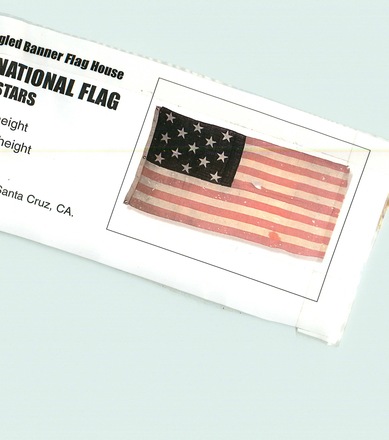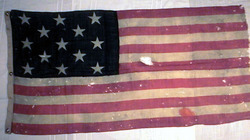

Obverse - edit
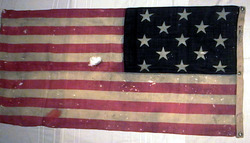
Reverse - edit
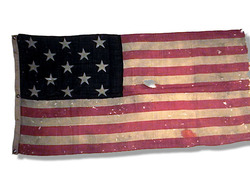
Obverse
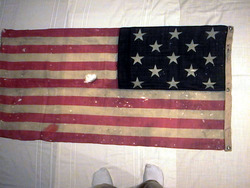
Reverse
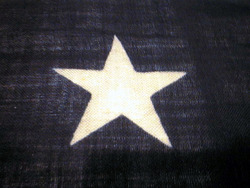
Obverse Star
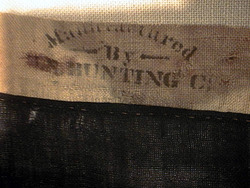
Reverse Detail
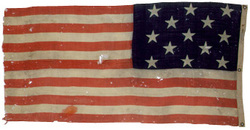
Reverse - Book

Book Photo
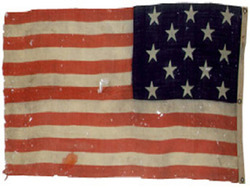
Book Photo - edit
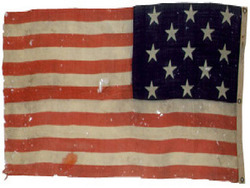
Reverse - edit
U.S. 13-Star Flag, Navy Boat Flag.
Sub-collection: Star Spangled Banner Flag House13 Star U.S Flag #14 Navy Boat Flag, 3-2-3-2-3 Star Pattern, manufactured by U.S. Bunting Co.
13 Star U.S Flag: manufactured by U.S. Bunting Co., the first American flag company, started by General Benjamin Butler (Lowell, Mass., 1865). This is a U.S. Navy boat flag of 1867. The star pattern is 3,2,3,2,3. It is an artifact from a transitional period in U.S. flag manufacturing, integrating block printing (new style) with the old style of piecing (i.e. stitching pieces together).
Until 1865, no wool bunting was manufactured in the United States. All bunting for flags were imported at the time from England, where cottage industry (later replaced by industrialized machine looms) in the Sudbury area had specialized in the making of wool bunting. During the American Civil War, the demand for US flags reached a high point, but the U.S. relations with England remained strained during the conflict. In early 1865, Benjamin Butler, a former governor of Massachusetts turned congressman (after an unsuccessful Army career) introduced legislation to demand that all military flags be made with American-made bunting. The legislation was self-serving, as he had begun to form the United States Bunting Company in Lowell, Massachusetts in partnership with D.W.C. Farrington. In addition to co-founding the U.S. Bunting Company, Farrington controlled Holts patents for resist or press dying of fabrics. In 1865 and 1866 the U.S. Bunting Company proposed to make all of the flags needed by the Army and the Navy. The Army had a substantial supply in stock at the War's end, but the Navy accepted the company's offer. This size No. 14 boat flag still bears the marks of the United States Bunting Company on its heading.
Exhibition History:
First Presidio Exhibit
(ZFC0013)
Thirteen-Star, United States Navy Boat Flag, No. 14
Second Presidio Exhibit Gallery One Copy 2003
ZFC0013
13-Star United States Navy Boat Flag No.14
Publication History:
Madaus, Howard M., Dr, Whitney Smith, The American Flag: Two Centuries of Concord and Conflict. Santa Cruz: VZ Publications, 2006, p. 26.
Provenance: Acquired by the Zaricor Flag Collection (ZFC0013) in 1996 from the Star-Spangled Banner Flag House Collection of Baltimore, MD.
ZFC Significant Flag
Item is Framed
Sources:
Madaus, Howard M.- Whitney Smith, The American Flag: Two Centuries of Concord and Conflict, VZ Publications, Santa Cruz, 2006.
Preble, George Henry, The History of the Flag of the United States of America, Boston, Houghton, Mifflin & Co. 1894.
US Navy "Boat" Flag , Dave Martucci's Flag Pages, 10 October 2011, from: http://www.vexman.net/smalboat.htm
U. S. Bunting, Lowell Land Trust.Org, 11 November 2011, from: http://lowelllandtrust.org/greenwayclassroom/history/USBunting.pdf
Image Credits
Zaricor Flag Collection
Hoist & Fly | |
|---|---|
| Width of Hoist | 57 |
| Length of Fly | 30 |
Union/Canton | |
|---|---|
| Width of Union/Canton | 25 |
| Length of Union/Canton | 16 |
Stars | |
|---|---|
| Size of Stars | 3.5 |
Stripes | |
|---|---|
| Width of 1st Stripe | 2.25 |
| Width of 3rd Stripe | 2.25 |
| Width of 8th Stripe | 2.25 |
| Width of Last Stripe | 2.5 |
| Size of Hoist | 1.5 |
Frame | |
|---|---|
| Is it framed? | yes |
| Frame Height | 37 |
| Frame Length | 64 |
Stars | |
|---|---|
| Number of Stars | 13 |
| How are the stars embeded? | Printed |
| Are there stars on obverse? | yes |
| Are there stars on reverse? | yes |
Stripes | |
|---|---|
| Number of Stripes | 13 |
| Color of Top Stripe | Red |
| Color of Bottom Stripe | Red |
| Has a Blood Stripe? | no |
Nationality | |
|---|---|
| Nation Represented | United States |
Fabric | |
|---|---|
| Fabric | Wool |
| Comments on Fabric | Bunting |
Stitching | |
|---|---|
| Stitching | Hand |
Condition | |
|---|---|
| Condition | Fair |
| Damage | Many small holes, red stain with big hole in the middle. |
| Displayable | yes |
Date | |
|---|---|
| Date | Circa 1867 |
Exhibits | |
|---|---|
| Exhibition Copy | First Presidio Exhibit (ZFC0013) THIRTEEN-STAR, UNITED STATES NAVY BOAT FLAG, NO. 14 Date: 1866-1870 Media: Wool bunting, with red and blue elements press dyed, hand-sewn sections. Comment: Until 1865, no wool bunting was manufactured in the United States. All bunting for flags were imported at the time from England, where cottage industry (later replaced by industrialized machine looms) in the Sudbury area had specialized in the making of wool bunting. During the American Civil War, the demand for US flags reached a high point, but the U.S. relations with England remained strained during the conflict. In early 1865, Benjamin Butler, a former governor of Massachusetts turned congressman (after an unsuccessful Army career) introduced legislation to demand that all military flags be made with American-made bunting. The legislation was self-serving, as he had begun to form the United States Bunting Company in Lowell, Massachusetts in partnership with D.W.C. Farrington. In addition to co-founding the U.S. Bunting Company, Farrington controlled Holts patents for resist or press dying of fabrics. In 1865 and 1866 the U.S. Bunting Company proposed to make all of the flags needed by the Army and the Navy. The Army had a substantial supply in stock at the War's end, but the Navy accepted the company's offer. This size No. 14 boat flag still bears the marks of the United States Bunting Company on its heading. Provenance: Acquired by the Zaricor Flag Collection (ZFC0013) in 1996 from the Star-Spangled Banner Flag House Collection of Baltimore, MD. Second Presidio Exhibit Gallery One Copy 2003 ZFC0013 13-Star United States Navy Boat Flag No.14 Date: 1866-1870 Media: Wool bunting with red and blue elements press-dyed; hand-sewn sections Comment: Wool bunting, the preferred fabric for making flags, was not manufactured in the United States until 1865. Until then, all bunting was imported from England, where the Sudbury area cottage industry, later replaced by machine looms, had specialized in making that fabric. During the American Civil War, the demand for United States flags reached unprecedented heights, but U.S. relations with England remained strained during the conflict. In early 1865 Benjamin Butler, after a checkered Army career, promoted legislation requiring all flags for the military be constructed with American-made bunting. The legislation was self-serving, as he had begun to form the United States Bunting Company in Lowell, Massachusetts, with D.W.C. Farrington. In addition to co-founding that firm, Farrington controlled Holts patents for resistor press-dyeing technology of fabrics. In 1865 -1866 the U.S. Bunting Company proposed to make all the flags needed by the Army and the Navy. The Army had a substantial supply in stock at the war's end, but the Navy accepted the company's offer. This size No.14 boat flag still bears the marks of the United States Bunting Company on its heading. Provenance: Acquired by the Zaricor Flag Collection (ZFC0013) in 1996 from the Star-Spangled Banner Flag House Collection of Baltimore, MD. A flag from the Star Spangled Banner Flag House Collection. |
Publications | |
|---|---|
| Publication Copy | Madaus, Howard M., Dr, Whitney Smith, The American Flag: Two Centuries of Concord and Conflict. Santa Cruz: VZ Publications, 2006, p. 26. 13-Star United States Navy Boat Flag, Size No. 14 Wool bunting, the favored fabric for making flags, was not manufactured in the United States until 1865. Until then, all bunting was imported from England, where the Sudbury area cottage industry (later replaced by machine looms) had specialized in making that fabric. During the American Civil War, the demand for United States flags reached new heights, but U.S. relations with England remained strained. In early 1865, the controversial Union general, politician and entrepreneur that was Benjamin Butler, garnered legislation requiring all flags for the military to be constructed with American-made bunting. The legislation was self-serving, as he had begun to form the United States Bunting Company in Lowell, Massachusetts, with D.W.C. Farrington. In addition to co-founding that firm, Farrington controlled Holt's patents for resist (or press) dyeing of fabrics. In 1865/1866, the U.S. Bunting Company proposed to make all the flags needed by the Army and the Navy. The Army had a substantial supply in stock at war's end, but the Navy accepted the company's offer. This size No.14 boat flag still bears the marks of the United States Bunting Company on its heading. Date: 1866 1870 Size: 30" hoist x 57" fly Medium: Wool bunting with red and blue elements press-dyed; hand-sewn sections Provenance: Acquired by the Zaricor Flag Collection in 1996 from the Star-Spangled Banner Flag House Collection of Baltimore, MD. ZFC0013 |





